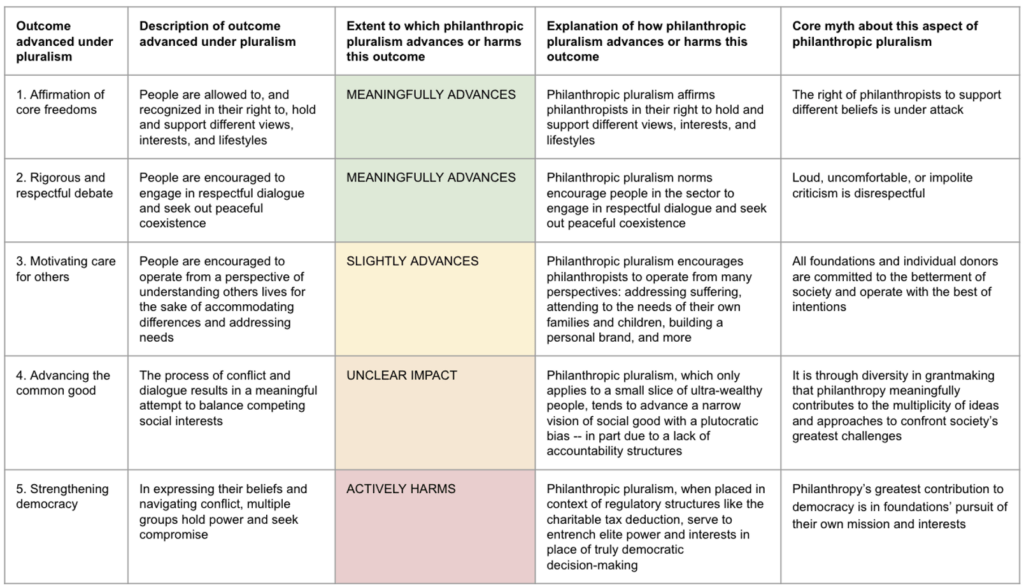
This article was updated on July 11, 2024.
Debates about philanthropic pluralism—the collective practice of philanthropists supporting the causes, ideas, and organizations of their choice—are as old as foundations themselves. When the Rockefellers sought to establish the formal structure of a foundation in the US tax code, they pushed to give themselves freedom of choice in who, what, and how they could give. Flexibility, in their view, would enable investment in the causes that government and business lacked the capacity or motivation to address.
Critics challenged this notion, believing that those who had amassed such wealth, typically through worker mistreatment, exploitation, and theft, could not represent any interests but their own. They felt such giving would only entrench plutocratic ideals in our social fabric and depress political radicalism. Even as the field has evolved, these debates have remained similar. The publication of an op-ed from six philanthropic leaders defending philanthropic pluralism in 2023 and the subsequent criticism reflected many of the same ideas from 100 years ago.
Debates about philanthropic pluralism…are as old as foundations themselves.
Part of the reason for this cyclical critique is that our field lacks a coherent framework of what “philanthropic pluralism” means. In particular, the use of the term “pluralism” implies that the benefits of pluralism—the philosophical idea that political bodies are impacted by diverse thought—also result from philanthropic pluralism. Defenders of philanthropic pluralism rely on this positive connotation, emphasizing the supposed democratic and social benefits of pluralism without recognizing how they may not apply in a philanthropic context.
Declaring philanthropy unambiguously pluralistic and, by extension, positive, contributes to a broader failure of philanthropy: a lack of honesty about the moral tradeoffs inherent in this work. Activists, advocates, and providers have concerns about power, accountability, and the “do-gooder” framing that only deepens without meaningful debate.
In this piece, I want to offer a framework to disentangle pluralism from philanthropic pluralism. It breaks down the outcomes promoted by pluralism writ large, explores how philanthropic pluralism advances those same outcomes, and considers what myths persist about the relationship between these two ideas.
In identifying the concrete impacts of philanthropic pluralism, I find that it is not, in fact, particularly pluralistic. Certain core tenets of pluralism, such as motivating care for others, advancing the common good, and strengthening democracy, are mitigated or reversed by philanthropic pluralism. A better term might be philanthropic plutocracy.
A better term might be philanthropic plutocracy.
I conclude with a call to action for the field: greater intellectual honesty in considering the inherent tradeoffs in philanthropic pluralism, tangible investment in alleviating the harms perpetuated by philanthropic pluralism, and pursuit of a “just transition.”
A Framework for Philanthropic Pluralism
I define philanthropic pluralism as the collective practice of philanthropists supporting the causes, ideas, and organizations of their choice. It is informed by the political philosophy of pluralism, which refers to the idea that people with different interests and convictions will peacefully coexist and participate in democracy.
The framework below breaks down five core outcomes of pluralism: affirmation of core freedoms, rigorous and respectful debate, motivating care for others, advancing the common good, and strengthening democracy. Within each outcome, the framework articulates the extent to which it is also advanced by philanthropic pluralism and explains why.

Of these, two outcomes of pluralism (affirmation of core freedoms and rigorous and respectful debate) are also advanced by philanthropic pluralism. When we affirm philanthropists’ right to support different views, it contributes to a broader cultural norm in which all people feel comfortable giving to a range of causes as well. And, as this freedom to give creates venues for rigorous and respectful debate in philanthropic spaces, it supports a broader norm of conversation across lines of difference and peaceful coexistence. (One important caveat is that loud, “impolite,” and disruptive criticism should often be considered respectful, even if it causes discomfort—for example, acts of civil disobedience and direct action.)
The other three outcomes (motivating care for others, advancing the common good, and strengthening democracy) are not meaningfully advanced by philanthropic pluralism.
Philanthropic Pluralism Does Not Necessarily Motivate Care for Others
Indeed, many philanthropists make decisions based on causes that they personally care about—many rooted in addressing people’s suffering. Furthermore, giving behavior can evoke feelings of generosity, happiness, and social connection, especially when aligned with our core values.
However, philanthropic pluralism also enables selfish and self-serving behavior. Philanthropists can operate with a range of motivations, not all of which are altruistic. They are free to back particular ideological viewpoints, policy prescriptions, and programs that aim to protect their wealth, often at the expense of others’ wellbeing.
Sign up for our free newsletters
Subscribe to NPQ's newsletters to have our top stories delivered directly to your inbox.
By signing up, you agree to our privacy policy and terms of use, and to receive messages from NPQ and our partners.
Take the giving of Charles and David Koch, for example. The Koch Family Foundation contributed to at least 90 groups working to obstruct government action on climate change, which will irreparably damage ecosystems, lives, and livelihoods. In other cases, philanthropists operate to elevate their names and harbor goodwill for themselves, their families, and their companies. Concern for others is often ultimately superseded by other priorities.
Philanthropic Pluralism Has Questionable Impacts on the Common Good
Research on how philanthropists give challenges conventional notions that philanthropy largely, or even primarily, benefits people experiencing poverty. Data from the Center on Philanthropy at Indiana University finds that even under generous assumptions, less than 20 percent of giving by millionaires addresses the needs of those in poverty. Other analyses have found that institutional philanthropy writ large is, at best, “modestly redistributive.” The freedom of selection guaranteed by philanthropic pluralism does not clearly advance a definition of the common good that centers on helping those with greater needs.
Philanthropic pluralism does not necessarily motivate care for others.
Particularly at issue here is how the lack of accountability structures in philanthropy combined with philanthropic pluralism can lead to significant benefit and significant harm. Many of philanthropy’s “highest impact” endeavors have benefited from the freedom to explore niche topics. Efforts to build schools and hospitals in the rural Southern United States, support nuclear nonproliferation, advance groundbreaking medical research, and resource social movements such as the marriage equality movement have made critical contributions to global wellbeing.
At the same time, the lack of accountability has allowed for great harm, including funding the forced sterilization of Indian men as part of “population control” programs and very recent financial support of White nationalist groups. Institutional philanthropies have been instrumental in funding the ideological, strategic, and tactical work to maintain money’s influence in politics, advance gerrymandering efforts, and invest in movements to roll back our fundamental rights—all actions enabled by the freedom of philanthropic pluralism.
Some assert that philanthropic pluralism enables the development of diverse ideas and approaches to confront society’s greatest challenges. This argument overstates philanthropy’s role in this endeavor. The private foundation has only existed in its current form in the United States for the last 100 years or so, but our nation’s history of elevating controversial and radical ideas is much longer.
Academics, activists, and everyday Americans have originated new ways of understanding the world and spread them across the globe to inspire social change. Philanthropic support can help give people the space and resources to explore such ideas, but to consider it essential is to overstate philanthropy’s contribution.
Philanthropic Pluralism Hinders Democracy
In pluralistic politics, the hope is that everyone expressing their own interests will drive toward a balance of competing interests. Modern US philanthropy can appear this way from the outside—foundations range from conservative to progressive. However, when we situate philanthropic pluralism within a system of philanthropy that concentrates capital and hoards power, we can see that it ultimately serves to entrench elite power and priorities in our laws, policies, and programs.
In his book Just Giving, Stanford professor Rob Reich highlights how the structures that regulate giving—namely, the charitable tax deduction—create a deeply inegalitarian giving landscape. The public funds forfeited through the tax deduction flow to the charities selected by the rich, who, under philanthropic pluralism, have complete freedom to define what is important to them. By definition, these interrelated structures redistribute power from the people to the wealthy.
This brings us to the crux of the issue: philanthropic pluralism is fundamentally oxymoronic. It offers the veneer of diversity while ignoring philanthropists’ generally shared interest in maintaining our political, economic, and cultural status quo. Because foundations give money that would otherwise be tax revenue for public benefit, providing philanthropists unfettered freedom to give according to their desires inherently restricts the public’s voice in democracy.
To ignore the full reality of the relationship between institutional philanthropy and democracy—not to mention the undemocratic means by which most philanthropists accrued wealth—reflects a warped sense of how these institutions fundamentally relate to one another. We must imagine new ways for philanthropy to engage with democracy, starting with philanthropists advocating for policies that democratize rather than hoard their own power.
How We Move Forward
My intention is not to advocate “for” or “against” philanthropic pluralism, which will likely continue in its current form given our current cultural and political norms. Instead, I hope to give our field the language and structure to have explicit discussions about the precise benefits and harms of philanthropic pluralism. Without honest conversations about these tradeoffs, we run the risk of a perpetual back and forth on terminology rather than substance.
Our field has a responsibility to directly invest resources in responding to the harms that philanthropic pluralism permits. This may include changes in internal practices, such as implementing community accountability structures and beginning work to identify and repair harms committed in the past. It must also include a collective effort to restructure or reimagine the laws and policies governing philanthropy, namely, structures like the charitable tax deduction that sit in opposition to democracy.
Over the long haul, the drawbacks of philanthropic pluralism strengthen the argument for a just transition for philanthropy. Intentional efforts to shift decision-making power to communities and prioritize wealth redistribution can serve to strengthen democratic norms and advance a truly “common” good.
Finally, I hope this serves as an invitation for philanthropic critics of all kinds to continue their work. Philanthropic power has grown exponentially over the last century, and we now sit at the precipice of an $84 trillion intergenerational wealth transfer. This astonishing level of wealth means that engaging in justice-oriented and democracy-preserving philanthropic practice is more salient than ever. We cannot allow demands for “respect” from philanthropic leaders under the guise of philanthropic pluralism to serve as a pretext for suppressing thoughtful criticism, rigorous debate, and collective action.








